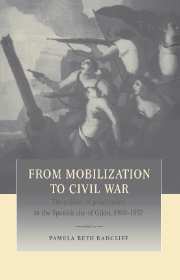Book contents
- Frontmatter
- Contents
- List of maps
- List of tables
- Acknowledgments
- Glossary of terms and abbreviations
- Introduction
- 1 A turning point: the city in 1900
- PART I Patterns of life in working-class Gijón
- PART II Institutional forces of opposition: republicans and anarchosyndicalists
- 4 The republican parties and municipal politics, 1900–1930
- 5 The republicans in power: municipal politics, 1931–1936
- 6 The trade union movement, 1900–1936
- PART III Defining an oppositional culture: the struggle over the public sphere
- PART IV The urban battlefield: conflict and collective action, 1901–1936
- Conclusion
- Appendix 1 Wage and price movement
- Appendix 2 Occupations by status category
- Appendix 3 Supplementary tables
- Select bibliography
- Index
6 - The trade union movement, 1900–1936
Published online by Cambridge University Press: 31 October 2009
- Frontmatter
- Contents
- List of maps
- List of tables
- Acknowledgments
- Glossary of terms and abbreviations
- Introduction
- 1 A turning point: the city in 1900
- PART I Patterns of life in working-class Gijón
- PART II Institutional forces of opposition: republicans and anarchosyndicalists
- 4 The republican parties and municipal politics, 1900–1930
- 5 The republicans in power: municipal politics, 1931–1936
- 6 The trade union movement, 1900–1936
- PART III Defining an oppositional culture: the struggle over the public sphere
- PART IV The urban battlefield: conflict and collective action, 1901–1936
- Conclusion
- Appendix 1 Wage and price movement
- Appendix 2 Occupations by status category
- Appendix 3 Supplementary tables
- Select bibliography
- Index
Summary
The trade union movement that burst onto the scene around the turn of the century fizzled out almost immediately, but over the next three decades it established itself as a powerful independent force in Gijón's political culture. Although it did not officially participate in elections or governmental institutions, the anarch-osyndicalist-dominated trade union movement came to define a radical political alternative to republicanism. Republicanism had a great impact on the labor movement and, more broadly, on the politicization of workers, but it lost control of that process early on. As republicanism became increasingly drawn into municipal politics, the new forces of anarchosyndicalism and Socialism battled to take control of the still inchoate labor movement. This struggle continued, on and off, until the two sides negotiated the “Workers' Alliance” in 1934, but after the first decade the Socialists were relegated to minority status. In direct contrast to the balance of forces at the provincial level, Gijón became an anarchist bastion in one of the staunchest Socialist regions in the country.
The question of why anarchosyndicalism prevailed in Gijón is linked to the broader dilemma about the divided Spanish labor movement that continues to intrigue historians. The survival of an anarchist-influenced labor movement well into the twentieth century, and the relative weakness of Socialism until the 1930s, have provoked a number of explanatory paradigms. Perhaps the most interesting aspect of the question has been why different versions of the labor movement flourished in certain areas of the country. Complicating this problem is the heterogeneity of the anarchosyndicalist movement, which makes it difficult to treat as a coherent phenomenon.
- Type
- Chapter
- Information
- From Mobilization to Civil WarThe Politics of Polarization in the Spanish City of Gijón, 1900–1937, pp. 167 - 194Publisher: Cambridge University PressPrint publication year: 1997



